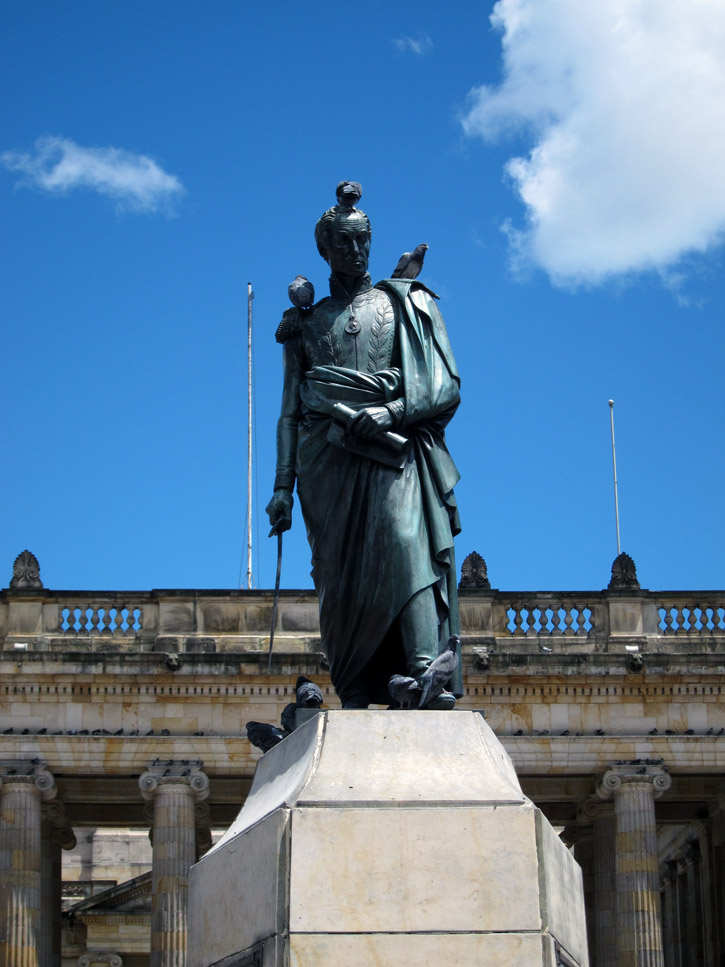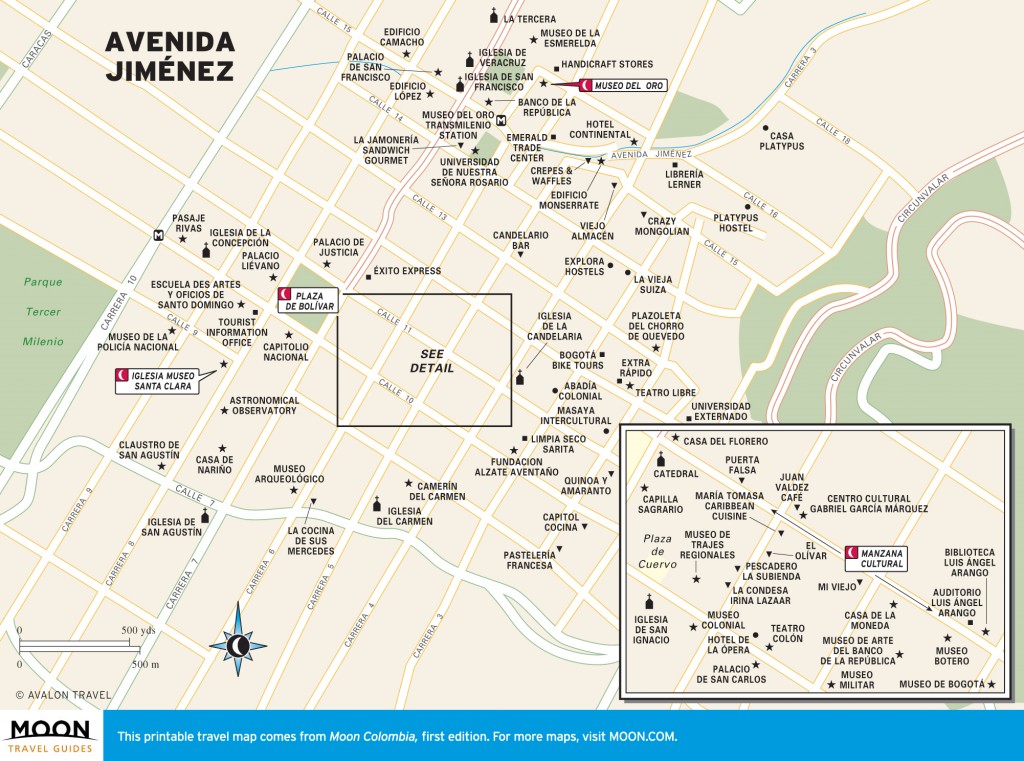Every respectable Colombian city has a Plaza de Bolívar, but none have quite the history as this one. Between Carreras 7-8 and Calles 10-11, the Plaza de Bolívar is the natural starting point for any tour of La Candelaria. Originally known as the Plaza Mayor, the plaza has had several reincarnations during its history. In colonial times, it was where the Friday market took place. It was also the setting for executions, including that of independence heroine Policarpa Salavarrieta (whose picture graces the $10,000 peso bill). Following the death of Simón Bolívar, Congress renamed the plaza in his honor in 1846. A diminutive statue of the “Liberator,” the first of many Bolívar statues in the world, stands in the middle of the plaza. Today the plaza is home to political demonstrations, inauguration ceremonies for the Bogotá mayor, and concerts.

Colombia’s most important and most photographed plaza is named for Simón Bolívar, the man who gave the country independence. Photo © fabulousfabs, licensed Creative Commons Attribution.
Next door to the cathedral is the Capilla El Sagrario (Cra. 7 No. 10-40, mass 7:30am and 5pm Mon.-Fri., 5pm Sun.). This chapel was built much earlier than the cathedral, in the 1600s, and is considered to be an excellent example of Santa Fe (as Bogotá was known) architecture. The interior is decorated with a Mudejar or Moorish-style vaulted wooden ceiling. Along the sides of the cross-shaped chapel are several large works depicting biblical scenes by Colombian baroque painter Gregorio Vásquez de Arce y Ceballos. A ceremony was held here to honor the army and Simón Bolívar following their decisive victory over the Spaniards at the Battle of Boyacá in 1819.
Across Calle 10 on the northeast corner of the plaza is the Casa del Florero (Cra. 7 No. 11-28, tel. 1/334-4150, 9am-5pm Tues.-Fri., 10am-4pm Sat.-Sun, COP$3,000), also known as the Museo del 20 de Julio or Museo de la Independencia. This small house used to be a general store run by a Spaniard, José González-Llorente. The story goes that his refusal to lend a vase to a pair of Creoles sparked the ire of either incredibly sensitive or cunning locals, who launched a protest during the busy market day against Spanish rule. Historians today dispute much of the tale, but the shattered remains of that colorful vase are exhibited today in the museum. Maybe the most interesting exhibit in the museum is a room that shows the transformation of the Plaza de Bolívar over time, with raw footage of two of the most traumatic events in recent Colombian history: the Bogotazo riots following the assassination of Jorge Eliécer Gaitán in 1948 and the siege of the Palacio de Justicia following a takeover by the M-19 guerrilla group in 1985. A free guided tour in English is given every Wednesday at 3pm.
The newest building on the plaza, completed in 1991, is the Palacio de Justicia on the north side. Housing the Supreme Court and other high courts, this building replaced the previous one, which was destroyed following the tragic events of 1985. (That building had replaced a previous justice building that was burned to the ground during the Bogotazo.) On November 6, 1985, M-19 guerrillas stormed the building, perhaps in cahoots with infamous drug kingpin Pablo Escobar, killing several justices and holding some 350 people in the building hostage. After hours of stand-off, the military counterattacked, coordinating their assault from the Casa del Florero. The fight concluded the next day with the building engulfed in flames, result of a military rocket. More than 100 people were killed. Controversy remains even today about the tragedy and the government’s actions. Several victims—mostly workers in the cafeteria—were seen being escorted to safety, never to be found again. Five years later the M-19 demobilized, becoming a political movement. Today, it is telling that there is not even a plaque mentioning the tragedy. Nevertheless, clearly some wounds have healed: former M-19 guerrilla Gustavo Petro was elected mayor in 2011, with his office (alcaldía) in the Palacio Liéviano on the west side of the plaza.
On the south side of the square is the neoclassical Capitolio Nacional, home of the bicameral Colombian Congress. Designed by architect Thomas Reed, the Capitolio took over 70 years to build, finally being completed in 1926. Gargoyles keep watch atop the building behind the Ionic columns of the front. For about two months in 2009 the entire facade was covered with 1,300 massive ants, a project of Colombian artist Rafael Gómezbarros. The work was a commentary on forced displacement resulting from Colombia’s armed conflict.

Avenida Jiménez
Excerpted from the First Edition of Moon Colombia.